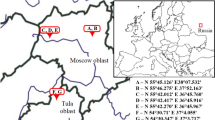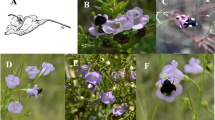Summary
Flower visitation records were obtained for 192 species of bees and 138 species of wasps in three neotropical habitats. Four indices of feeding specialization were calculated for common species, and similar patterns were observed using each index. Variation in specialization could be attributed to several factors: the habitat and season in which species were found, the degree of sociality of species, and whether species were bees or wasps. Important differences among habitats and seasons were the number of coexisting consumer species and the species richness and phenology of resource plants. Differences in average consumer specialization among habitats and seasons may have been the result of differences in competitive pressures and to a lesser extent, differences in the flowering strategies of local plants. Eusocial bees and wasps were much more generalized in feeding than solitary species, and bees were more generalized than wasps. Bees in these neotropical communities were much less specialized than their north temperate counterparts. This pattern is reflected by the near absence of species that feed at only one or two plant species in Guanacaste, as compared to a very high frequency of these extreme specialist species in north temperate areas. Temperate zone species of bees have less “even” visitation rates to their resources than tropical bees. Consequently, temperate zone bees are more specialized in both the variety of plant species visited and the dominance of visitation to each set of resource plants. Several hypotheses are examined as possible explanations for this apparent qualitative difference in community structure between neotropical and temperate communities.
Similar content being viewed by others
References
Beard, J.S.: The savanna vetetation of northern tropical America. Ecol. Monogr. 23, 149–215 (1953)
Cody, M.L.: Competition and the structure of bird communities. Princeton, Princeton Univ. Press, N.J. (1974)
Colwell, R.K.: Competition and coexistence in a simple tropical community. Am. Nat. 107, 737–760 (1974)
Colwell, R.K., Futuyma, D.J.: On the measurement of niche breadth and overlap. Ecology 52, 567–576 (1971)
Connell, J.H.: Some mechanisms producing structure in natural communities: a model and evidence from field experiments. pp 460–490. In: Ecology and Evolution of Communities (M.L. Cody and J.M. Diamond eds.), Cambridge, Massachusetts: Harvard University Press 1975
Fager, E.W.: Diversity: a sampling study Amer. Natur. 106, 293–310 (1972)
Frankie, G.W.: Tropical forest phenology and pollinator plant coevolution. pp. 192–209. In: Coevolution of Animals and Plants (L.E. Gilbert and P.H. Raven eds.), Austin: University of Texas Press 1975
Frankie, G.W.: Pollination of widely dispersed trees by animals in Central America, with an emphasis on bee pollination systems. pp. 151–159. In: Tropical Trees, Variation, Breeding and Conservation, (J. Burley and B.T. Styles eds.), London: Academic Press 1976
Frankie, G.W., Baker, H.G.: The importance of pollinator behavior in the reproductive biology of tropical trees. Anal. Inst. Biologia (Botanica), No. 45 (1974)
Frankie, G.W., Baker, H.G., Opler, P.A.: Comparative phenological studies of trees in tropical wet and dry forests in the lowlands of Costa Rica. Jour. Ecol. 62, 881–913 (1974)
Frankie,G.W., Opler, P.A., Bawa, K.S.: Foraging behavior of solitary bees: implications for outcrossing of a neotropical forest tree species. Jour. Ecol. 64, 1049–1057 (1976)
Heinrich, B.: Resource partitioning among some eusocial insects: bumblebees. Ecology 57, 874–889 (1976)
Heithaus, E.R.: Species diversity and resource partitioning in four neotropical plant-pollinator communities. Ph.D. Thesis, 148 pp., University of Michigan, Microfilm Services of Stanford University (1973)
Heithaus, E.R.: The role of plant-pollinator interactions in determining community structure. Ann. Missouri Bot. Gard. 61, 675–691 (1974)
Heithaus, E.R.: Species richness and phenology of bees and wasps in three neotropical habitats. Ecology (1979a, in press)
Heithaus, E.R.: Flower visitation records and resource overlap of bees and wasps in northeast Costa Rica. Brenesia, in press (1979b)
Holdridge, L.R.: Life Zone Ecology. Tropical Science Center, San Jose, Costa Rica (1967)
Hubbell, S.P., Johnson, L.K.: Competition and nest spacing in a tropical stingless bee community. Ecology 58, 949–963 (1977)
Janzen, D.H.: Synchronization of sexual reproduction of trees within the dry season in Central America. Evolution 21, 620–637 (1967)
Johnson, L.K., Hubbell, S.P.: Aggression and competition among stingless bees: field studies. Ecology 55, 120–127 (1974)
Johnson, L.K., Hubbell, S.P.: Contrasting foraging strategies and coexistence of two bee species on a single resource. Ecology 56, 1398–1406 (1975)
Linsley, E.G.: The ecology of solitary bees. Hilgardia 27, 534–599 (1958)
Linsley, E.G.: The role of flower specificity in the evolution of solitary bees. XI Internationaler Kongress für Entomologie Wien 1960. Sonderdruck aus den Verhandlungen BO. I (1961)
MacArthur, R.: Patterns of communities in the tropics. Biol. J. Linnaean Soc. 1, 19–30 (1969)
MacArthur, R.: Geographical Ecology, Harper and Row, Publishers. New York (1972)
Michener, C.D.: Bees of Panama. Bull. Amer. Mus. Natur. Hist. 104, 1–176 (1954)
Michener, C.D.: The Social Behavior of the Bees. A Comparative Study. The Belknap Press of Harvard University Press, Cambridge, Mass. (1974)
Moldenke, A.R.: Niche specialization and species diversity along a California transect. Oecologia 21, 219–242 (1975)
Moldenke, A.R.: California pollinator ecology and vegetation types. Phytologia 34, 304–361 (1976a)
Moldenke, A.R., Evolutionary history and diversity of the bee faunas of Chile and Pacific North America. Wassman Journal of Biology 34, 147–178 (1976b)
Moldenke, A.R., Neff, J.L.: Studies on pollination ecology and species diversity of natural California plant communities II. IBP Origin and Structure of Ecosystems Technical Report 74-13, 1–233 (1974)
Nie, N.H., Hull, C.H., Jenkins, J.G., Stienbrenner, K., Bent, D.H.: SPSS Statistical Package for the Social Sciences, Second Edition, New York: McGraw-Hill (1975)
Opler, P.A., Frankie, G.W., Baker, H.G.: Rainfall as a factor in the release, timing, and synchronization of anthesis by tropical trees and shrubs. Jour. Biogeogr. 3, 231–236 (1976)
Pearson, J.F.W.: Studies on the ecological relations of bees in the Chicago region. Ecol. Monogr. 3, 373–441 (1933)
Pianka, E.R.: Competition and niche theory. In: (R.M. May ed.), Theoretical ecology. W.B. Saunders Co., Philadelphia. 114–141 (1976)
Price, P.W.: Niche breadth and dominance of parasitic insects sharing the same host species. Ecology 52, 587–596 (1971)
Primack, R.B., Howe, H.F.: Interference competition between a himmingbird (Amazilla tzacatl) and skipper butterflies (Hesperiidae). Biotropica 7, 55–78 (1975)
Roubik, D.W.: Competitive interactions between neotropical pollinators and Africanized honey bees. Science 201, 1030–1032 (1978)
Sakagami, S.F., Fukuda, H.: Wild bee survey at the campus of Hoddaido University. J. Fac. Sci. Hokkaido Univ. Ser. VI, Zool. 19, 190–250 (1973)
Sakagami, S.F., Laroca, S., Moure, J.S.: Wild bee biocoenotics in Sao Jose dos Pinhais PR, South Brazil. Preliminary report. J. Fac. Sci. Hoddaido Univ. Ser. VI, Zool. 16, 253–291 (1967)
Schoener, T.W.: Theory of feeding strategies. Ann. Rev. Ecol. Syst. 2, 369–404 (1971)
Sokal, R.R., Rohlf, F.J.: Biometry. W.H. Freeman and Co., San Francisco (1969)
Stephen, W.P., Bohart, G.E., Torchio, P.F.: The Biology and External Morphology of Bees With a Synopsis of the Genera of Northwestern America. Agricult. Expt. Station, Oregon State University, Corvallis (1969)
Vandermeer, J.H.: Niche Theory. Ann. Rev. Ecol. Syst. 3, 107–132 (1972)
Author information
Authors and Affiliations
Rights and permissions
About this article
Cite this article
Raymond Heithaus, E. Flower-feeding specialization in wild bee and wasp communities in seasonal neotropical habitats. Oecologia 42, 179–194 (1979). https://doi.org/10.1007/BF00344856
Received:
Issue Date:
DOI: https://doi.org/10.1007/BF00344856




